The
fascination with the land of the Pharaohs has cast a spell over people
of all historical ages. The incredible monuments, which are still standing,
everlasting memorials digging into our imaginations. The centuries after
the Pharaohs cast a shadow over the Gods of Ancient Egypt, and new religions
overthrew the old ones with each conquering battle. The sands encroached
over time, burying the history form sight and mind.
In
1798, Napoleon Bonaparte invaded Egypt; he brought scholars with him to
study these colossal monuments. Tragically a stray cannonball denied the
Sphinx of its nose. The translation of its hieroglyphs were a complete
mystery, then came the discovery of the century the discovery of the
Rosetta Stone. What a find, finally there was a chance of translating,
but it wasn’t until 1822 that Champollion finally pieced together this
ancient language of the Pharaohs, which finally brought glorious life to
all the monuments.
Legend.
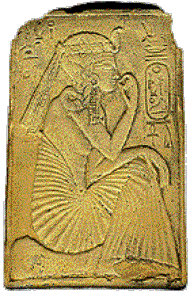
In
the days when the gods governed Egypt, the sky goddess Nut gave birth to
four divine children. Osiris, Isis, Nephthys and Seth. The first three
were beautiful, pure and full of wisdom, but Seth had a heart of pure evil.
Osiris
was destined to sit on the throne of the Pharaohs with his wife Isis (also
his sister) by his side. Osiris ruled Egypt for many years and was loved
and adored by his people who approved of his just and wise decisions. Seth
despised this adoration of Osiris, and overcome with jealousy, resolved
to murder his brother and proclaim himself Pharaoh in his place.
Seth
had a plan to trap Osiris. He built a beautiful inlaid chest, made to Osiris’
exact measurements. During a banquet that he threw he offered the chest
as a prize to whoever the chest fitted. No one was successful until Osiris
tried it. As soon as he lay down in the chest, Seth slammed down the lid
that locked Osiris in alive. Seth sealed the chest with lead and threw
it into the River Nile and took his place as Pharaoh and Egypt succumbed
to his rule.
After
one violent storm the chest was washed up onto the shores of Byblos, where
it became tangled in the branches of a large tree and hidden over time.
The tree was eventually cut down and used as a pillar at the palace. Isis
mourned the death of her husband and searched for his body. Finally she
arrived at Byblos, where with the help of the Queen, cut open the pillar
and freed Osiris’ body.
Isis
returned to Egypt to arrange her husband’s burial and hid Osiris’ body
in the marshes. To her dismay Seth found the body, dismembered it and scattered
the pieces worldwide. Isis beseeched her sister Nephthys for help, and
transforming into two giant birds, they searched for Osiris’ parts and
returned them to Egypt. One piece was missing his penis. This had been
consumed by a hungry Nile fish. Unhindered by this, Isis made him a replica
before reciting a spell that would resurrect her husband.
Isis’s
magic was strong and effective and soon she was pregnant with Osiris’ son
Horus. Horus grew up with revenge in mind, overthrowing his uncle; Horus
took his rightful place as Pharaoh of Egypt. Osiris ruled his own land
the Kingdom of the Dead.
From
then onwards the living King of Egypt was identified as Horus and the dead
Kings became one with Osiris.
Pyramids
& the Sphinx.
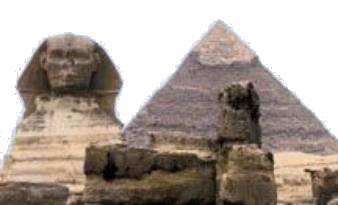
Egyptologists
believe that the Sphinx and pyramids were built around 2500BC, but there
is speculation that the Sphinx is considerably older and it predates the
Egyptians and originally had a head of a Lion, which was later carved in
the image of a Pharaoh from the Old Kingdom. The Sphinx is carved from
a natural outcrop of limestone. It is believed that the Sphinx is the earth
image of the constellation Leo in the heavens at around 10,500BCE. A geologist
did some research on the Sphinx and he believes that the erosion of the
body was done by rainwater and not by sand. He believes we should be looking
to times before 3000 BCE because of the extent of the erosion. He has said
that the extent of the erosion indicates to the dates between 7,000 10,000BCE
for the body. The head however though damaged is not as eroded as the body,
is smaller in dimension compared to the body, and has had extensive work
done to it over the millennia.
The
pyramids are supposed to represent the belt of Orion, another constellation
and that they are of the same age. Egyptologists strongly dispute these
claims as preposterous. The structure of the Pyramid was invented by Imhotep,
the chief architect of Djoser (circa 2,700BCE) He discovered how to make
a tomb for his king in whose appearance would symbolise the ascent of the
soul. The result was the step pyramid at Saqqara, a pyramid with 6 steps.
Imhotep was later defined as the patron saint of scholars. The 4th Dynasty’s
first Pharaoh was Snofru. He has three Pyramids at two sites, one at Maidum
and two at Dashur.
The
Pyramids of Khufu (Cheops), Khephren and Menkera dominate the Giza Plateau
These are a fabulous legacy to the reign of these three Monarchs of the
4th Dynasty.
The
plans of Pharaohs architects were flawless. The base of Khufu’s Pyramid
differs in level by less than an 1/8 th of and inch. There are nearly 2,500,000
stone blocks, each weighing approximately 2 ½ tons. The outer blocks
have perfectly horizontal surfaces. Herodotus, the Greek historian, has
it that it would have taken 100,000 men working in shifts of 20,000 at
a time 20 years to build the Great Pyramid.
Rituals.
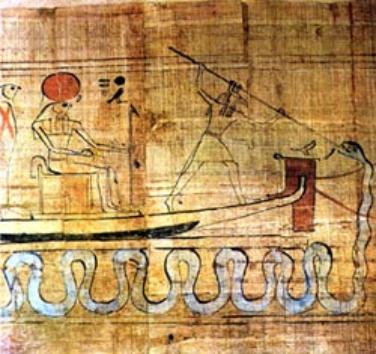
Funerary
Rituals
Near the sarcophagus there were wooden frames with tapestries
showing the mummified body of Osiris. These were covered with sand and
barley seed and watered for a number of days. When the barley germinated
to about 4-5 inches the frames were left to dry, then wrapped in cloth.
The custom was left as a reminder that even the great Osiris had vegetated
prior to being resurrected.
Nile Ritual
Every year on the 15th of August, the Pharaoh would throw a young virgin
into the Nile, as an offering, to celebrate the flooding and the proceeding
harvest.
Morning
Ritual at the Great Temple of Horus
The needs of the Gods are like
the needs of man, one of them is that they eat three times a day. At dawn,
a priest would bring in water from the sacred well and food offering would
be purified. The High Priest, holding a candle, enters the sanctuary and
checks that all the precious artefacts are in their rightful place. He
will then climb the steps leading to the Naos and breaks the seal from
the night before; he will enter and renew the offerings. All this time
he would be burning frankincense. The priest then begins the God’s absolutions.
For this the priest would use red, green, blue and white bandages. He anoints
the God with ointment and performs a purifying ceremony, using water and
natron, which is sprinkled four times around the Naos.
Contending
of Horus and Seth
This was re-enacted in the form of a play. These
performances were held in temples to celebrate certain festivals, such
as the Winter Festival celebrated at Edfu to commemorate Horus’ victory
over Seth. Priests wearing masks normally played this.
Back to top
Funerary
Practices.
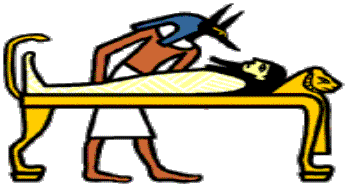
The
Ancient Egyptians had a fear of the hereafter. Death was a really dramatic
affair. The Egyptians spent their whole lives making sure that the pleased
the spirit of Maat, knowing that when they die they would be judged. The
construction of the tomb was an elaborate affair. It had to be large enough
to house all the possessions essential to their survival in the hereafter.
They had to be built for eternity.
An
Egyptian tomb had 2 parts for 2 functions. The underground chamber accessible
by a shaft, was for the burial of the body and the funerary equipment.
The chapel in the upper areas was the contact point between the living
and the dead. Family and priests gathered here.
The
tombs would be inscribed with blessings and prayer and also with curses
to try and protect it from violation from thieves. To the poor people of
Egypt, their eternal homes were less spectacular; usually a small rectangular
pit dug into the surface of the sand. The body would be wrapped up in a
mat with only a few clay vessels and amulets.
Mummification
was developed in Egypt as early as the 3rd Dynasty and it was to protect
the body for the long journey to the hereafter. The body had to be preserved
for the reunity of the spiritual and physical elements.
The
Egyptians developed sophisticated techniques to perfect the aversion of
bodily decay. First attempts were crude, but by 2,600BCE they started to
be more careful. Firstly removing the internal organs and placing them
into 5 canopic jars and removing the brain with special spoons inserted
through the nose. The flash was then covered in Natron (a sodium carbonate
base) to dry out the flesh for 90 days, only then could the body be wrapped
in bandages.
A
priest would carry out the opening of the mouth ceremony, which meant that
normal activities such as breathing, speaking, moving and eating were restored
in the hereafter. Only after these rituals would the body be ready for
burial.
Hieroglyphs.
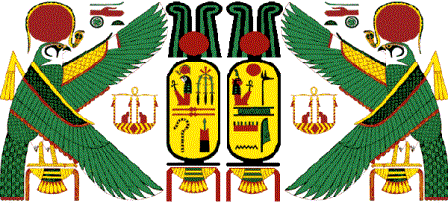
This
word comes from the ancient Greek and means “Sacred Carvings”
There
were 5 main stages in the Ancient Egyptian language:
OLD EGYPTIAN;
The language of the inscriptions of the Old Kingdom (circa 2650BC 2135BC),
the period in which the first continuous texts appear.
MIDDLE EGYPTIAN;
This language was around the time of the first Intermediate period and
the Middle Kingdom (circa 2135BC 1786BC). This was regarded as the classical
stage of the language used in literacy, religious and monumental inscriptions
through to the Greco-Roman Period. Very close to Old Egyptian in structure.
LATE EGYPTIAN;
This everyday language of the New Kingdom and Third Intermediate Period
(circa 1500BC 700BC), as witnessed particulary in secular documents of
the Ramesside Period (circa 1300BC 1080BC) also found to some extent
in literacy and monumental inscriptions. Very different from Old &
Middle Egyptian, especially in its verbal structure.
DEMOTIC;
Vernacular successor of Late Egyptian, written in the script known as Demotic,
attested from the beginning of the Late Egyptian Period down to the late
Roman times (circa 700BC 5AD)
COPTIC;
The
final stage of the language, as written in the Coptic script from the 3rd
Century onwards.
This site
complies to the RNIB design for ease of reading for partially sighted people
Please click here to download a program that will allow you to have web pages spoken to you.
to download a program that will allow you to have web pages spoken to you.



